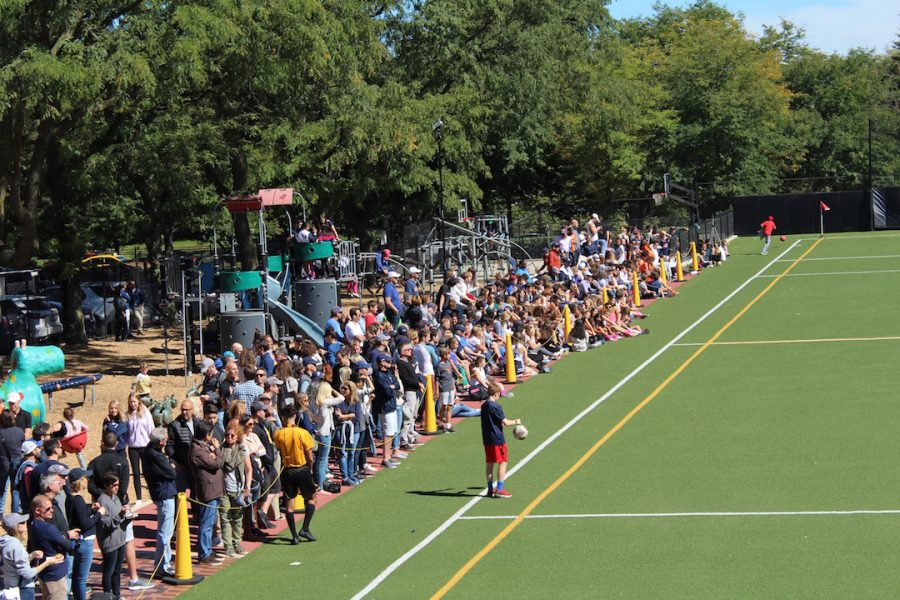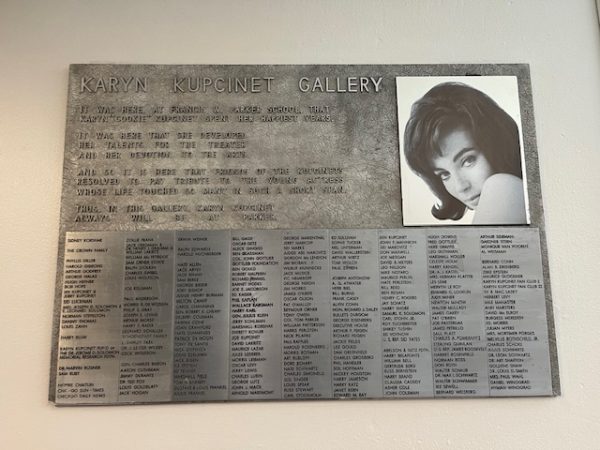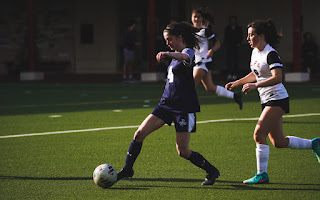Bleacher Report
Support for Girls Athletics Not On Par With the Boys
Photo credit: Anna Fuder
A large crowd gathers for the Boys Varsity Soccer Game.
“Oh, but it’s girls field hockey.”
Junior Senna Gardner was in a conversation about the Varsity Field Hockey team’s success last fall when she heard a male student use these words to dismiss it. The team’s winning record allowed it to claim the Regional title in the Illinois Field Hockey Association’s state tournament without actually playing a game for it — still, this student indicated that boys soccer didn’t earn the same accomplishment only because girls field hockey is less competitive.
Senior Elisabye Slaymaker, a varsity field hockey player and captain of both the girls basketball and softball teams, has also heard demeaning comments about girls’ athletics. “A lot of boys say if they’d played teams we play in field hockey, even if they had no experience, they’d win,” Slaymaker said.
To Gardner, girls sports “are viewed as a joke.” Other female athletes in the Upper School agree.
“There’s pressure on female athletes to prove that you’re not a joke,” junior Natalie Daskal, a basketball captain, said. “Girls really have to fight to gain respect of people throughout the school and prove they’re just as competitive, just as strong, and just as talented as male athletes.”
To Slaymaker, who’s also a head of the Student Athletic Council (SAC), a lack of support from the community for female athletes is evident by smaller crowds at girls’ games compared to the boys’. “They always get all the audience,” Slaymaker said, “and all the credit for playing sports.”
In past years, the Homecoming field hockey game would take place right before soccer — and according to Gardner, Slaymaker, and Field Hockey Captain Jade Rasmussen, most fans would just come to watch soccer.
To Rasmussen, a senior, low attendance at girls’ games is discouraging. “It kind of sucks when you’re playing a game, and it’s a really good game, but the only people there are parents and siblings,” she said, “and no one else is there to support us.”
After some field hockey players spoke to the Athletic Department, it scheduled field hockey as the final Homecoming game to encourage students to stay after soccer. According to Assistant Athletic Director Laura Gill, the change helped raise the girls’ turnout, and going forward, the last game will alternate between field hockey and boys’ soccer.
Even with the switch in the schedule, the bleachers still weren’t equally full for both field hockey and boys’ soccer.
Part of the reason, according to varsity soccer player Ryan Humphrey, a junior, could be the difference in sport. “Soccer is a more well-known,” he said, “and people can follow along easier than in field hockey. I stayed for field hockey, but I didn’t really understand — I couldn’t name two rules — and I could see why people don’t find it as entertaining if they’re not following along.”
Also, to Volleyball Captain Annette Njei, the social aspect of watching games, rather than the game itself, is a major factor in the Homecoming turnout. “If you go to the boys’ game with your friends, but then your friends don’t want to stay for field hockey, you don’t want to go by yourself,” Njei said. “It’s pretty sad.”
Junior Celeste Gerbaulet-Vanasse sees the social component of athletic events impact the attendance of the “White Out” basketball games at DePaul’s McGrath Arena. “I think it has to do with some people thinking boys are better at basketball,” she said, “but also the fact that everyone goes to the boys’ game, and thinks that the girls’ game won’t be as fun because not as many people are going to it.”
In recent years, the Girls’ Varsity Basketball team has played Senn High School first, with the stands sparsely occupied by parents, friends of players, and the boys’ team. During the boys’ game against rival Latin, though, both sides of the gymnasium have been nearly filled with fans decked out in their school colors, showing off signs made to cheer on their team or diss the other.
“It’s ridiculous,” Slaymaker said. “The second the girls’ game ends, there’s a hundred more people in the arena.”
Junior Gabe Rothschild, a varsity basketball captain, sees the importance of the boys’ team watching the girls. “It’s to support the girls,” Rothschild said. “Not as many people go to the girls’ game, and personally, I think it’s unfair.”
According to Slaymaker, increasing attendance at girls’ sporting events has come up in SAC meetings, where student representatives work with Athletic Director Bobby Starks to improve Parker athletics. Slaymaker proposed ideas like charging entrance fees to the boys’ “White Out” game, but not the girls’ — it wasn’t approved — to incentivize coming to both games.
“The attendance at girls’ basketball versus boys’ basketball “White Out” games is just a given in a way,” Slaymaker said. “Everyone expects the number won’t be the same, so there’s just not much the Athletic Department can worry about — it doesn’t do anything wrong with the schedule of games, there’s just not the same amount of support from the community.”
The disparity in viewership of girls and boys’ sports isn’t unique to Parker, and is present in collegiate and professional athletics. For example, in the 2017 season, the NBA averaged 1.19 million viewers per game, while the WNBA had a mere 171,000, according to “Variety.”
Still, Gardner thinks the Athletic Department should do more to encourage the community to watch girls’ teams compete. “There are some underlying things that could be quick fixes,” Gardner said. “Last year, the boys’ baseball team had this big game on a Friday night and the Athletic Department sent out this big email saying to come and support them, but the girls’ soccer and softball teams didn’t get the same shoutout. It’s those little things that you see that make you wonder why that’s even the case.”
For Gill, who spoke on behalf of the Athletic Department while Starks was on paternity leave, meaningful change will have to come from students. “We’ve offered some prizes, we did halftime shows at girls’ games, and we’ve still gotten a smaller crowd,” Gill said. “The Athletic Department can throw a circus, but if nobody comes, there’s not much we can do. It comes down to to both girls and boys wanting to support the female athletes.”
Gardner agrees that the student body should make more of an effort to attend girls’ competitions. “Show up for yourself, see what it’s like, don’t let someone else’s nonsense opinion determine how you view female athletics,” Gardner said. “We’re also a varsity team, we are also good players, we deserve the same support.”













